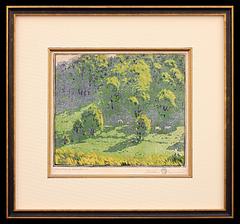Gustave Baumann
| male | 1881-1971 |
|
Life city:
Nashville, IN |
|
|
Work city:
Nashville, IN |
|
| Styles: Woodblock Prints Engravings Etchings Graphics Illustrations Landscapes Watercolors |
|
Drop us a note on your art or call the gallery (317) 253-5910.
Gustave Baumann was born on June 27, 1881 in Magdeburg, Germany. He immigrated to America with his family when he was ten and settled in Chicago. At the age of sixteen he began working as an apprentice for an engraving company while taking night classes at the Art Institute of Chicago. Here he studied painting, drawing, design and also carved toys and wood figures. By 1903 he started his own business as a commercial artist. With money saved from this business he was able to leave in 1905 for Munich, Germany where he enrolled in the Kunstgewerbe Schule. He studied with Maximillian Dasio and mastered the technique of color woodblock prints. After a year in Munich, in 1906, Gustave returned to Chicago and worked as a commercial artist all the while looking for a way to pursue printmaking as an art form rather than as a trade. In 1909 he executed his first limited edition color woodcuts which were exhibited at the Art Institute. It was also at this time that Baumann developed his own personal seal, the image of a hand opened over a heart, which was his pledge to make his craftwork available to those who might take pleasure from it. In 1909 Baumann moved to Brown County, Indiana. The hills, valleys and people here became his subjects and he produced a portfolio of colored woodcuts entitled “In the Hills of Brownâ€. These were shown at the 1915 Panama Pacific International Exposition in San Francisco where Baumann won the gold medal for printmaking. Baumann also held exhibits in the 1911 Paris salon and, in 1913, at the John Herron Art Instute, his first solo exhibit. In 1916 he organized the first national exhibition for color woodcuts at the Chicago Art Institute. Up until the time of Bauman, graphic art in the Western world had been mostly monochromatic and was used primarily in commercial art. As an admirer of the Japanese printmakers, Baumann added color to his art prints. Few other American printmakers were using color and none of them achieved the same artistic level as Baumann. His art was extremely time consuming as each color required its own block, some prints needing as many as eight blocks. James Whitcomb Riley appreciated his work and commissioned Gustave to create a series of prints for his book All the Year Round, published in 1912. In 1917 Baumann closed his Nashville studio in Brown County and eventually ventured west, first to Taos in 1918 and then on to Santa Fe. The colors of the southwest appealed to him and he was embraced by the Santa Fe arts community. He was elected an associate of the Taos Society of Artists and was a founding member of the Society of New Mexico Painters and the Santa Fe Art Club. By the time of his death in Santa Fe at the age of ninety, he had created more than three hundred prints. He died on October 8, 1971. We are extremely interested in purchasing works by Gustave Baumann. Please contact us if you have pieces you are considering selling.
Can you tell us more about the life or art of Gustave Baumann? Please contact us if you can add to our biography.




































.jpg)


